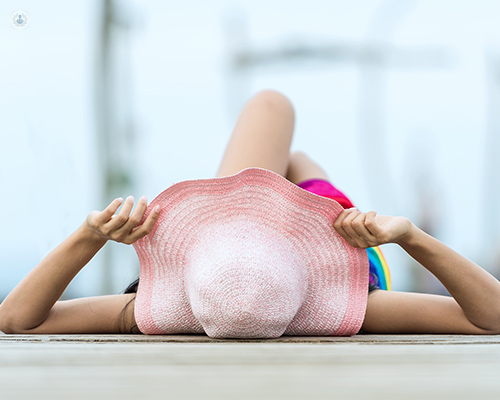What does sunlight do to my skin?
Escrito por:Skin cancer is the uncontrolled and unpredictable growth of certain cells in the skin and is caused by a combination of genetic and environmental factors. We can’t do an awful lot about genetic factors. We can’t choose our parents and we can't, at the present time, alter our abnormal DNA although that may change in the future. But what we can try and control to a certain extent are the damaging phenomena in our environment that predispose us to skin cancer and here, I am talking about sunlight.

How does sunlight damage the skin?
Sunlight consists of a lot of radiation which is essential for life on earth and reaches us through the atmosphere from the sun. It has a whole range of rays in it; very low wavelength, high energy, x-rays, ionizing radiation, ultraviolet C and so forth. These are cut off from our atmosphere and are very biologically active and dangerous. They may not reach us but what does reach us here on earth are the ultraviolet rays: ultraviolet B and ultraviolet A rays.
What UVB does to our DNA is cross links the purine and pyrimidine bases. In other words, the building blocks in our DNA. It is tattooing our DNA, which eventually leads to cancer. UVA is a slightly longer ultraviolet that we used to think was not damaging but now we know that it is although it doesn't directly attack the DNA. It causes excited oxygen species and other free radicals to form and they then damage our DNA strands.
So both UVB and UVA radiation cause skin cancer. When we’re exposed to ultraviolet our skin tans, which is through the melanocytes in our skin. The skin that produce the pigment melanin produce even more and sends the melanin out as a response to DNA damage. It’s a protective response to try and stop us getting more damage but the trigger for it is damage. In other words, there is no such thing as a safe tan.
What are the different types of skin cancer?
Skin cancer is classified as melanoma skin cancer and non-melanoma skin cancer. Melanoma skin cancer comes from the melanocytes, the pigment cells in our skin and non-melanoma skin cancer encompasses basal cell carcinomas or squamous cell carcinomas.
The other name for basal cell carcinoma is a rodent ulcer which you may have heard of and these are very common indeed. They are directly related to sun exposure and are more common in fair-skinned individuals. They do not spread elsewhere in the body, so they are not life-threatening. However, they can be locally recurrent and infiltrative hence the name rodent implying sort of local gnawing away.
Squamous cell carcinoma can spread elsewhere in skin and melanoma is unpredictable and that can also spread. As always, prevention is better than cure so keep out of the sun and reduce your risk of getting skin cancer.
How can I prevent sun damage and skin cancer?
We protect ourselves from skin cancer by protecting ourselves from sunlight which is the environmental agent that mutates our DNA and therefore causes skin cancer. And we protect ourselves from sunlight by using sun cream although sun cream is not the only answer. Before using sun cream, or as well as using sun cream, we must keep out of the sun particularly between the hours 11 and 3.
When we’re abroad in a sunny place between the hours of 11 and 3 those UVB rays, which are the rays that are directly mutating our DNA, are at their strongest. So between 11 and 3, we should be indoors, having a nice lunch, having a siesta, and only re-emerging after 3 o'clock. When we are exposed to sunlight, we should cover up. We should wear a hat and protective clothing and remember that UV rays can penetrate through loosely woven clothing. And then we must remember to use our sun cream, which is not the be all and end all.
The mistakes we make using sun cream is firstly, we put it on too late. By the time we put it on, we’ve already unbeknown to us damaged our DNA. The other mistake we make is that we don't put enough on. None of us put enough on to get the protection we think we’re getting. You have to put an awful lot on and there is also the issue of reapplication. To summarise, we should keep out of the sun, cover up when we’re exposed and use sun cream liberally and reapply it.


